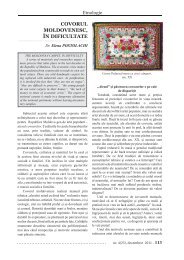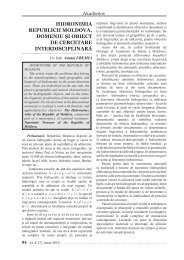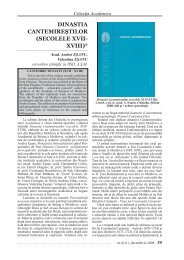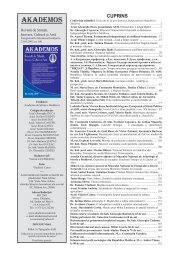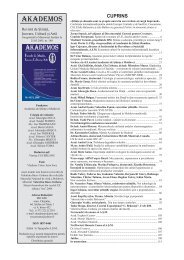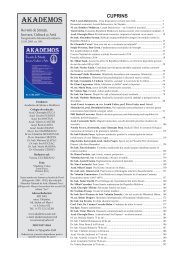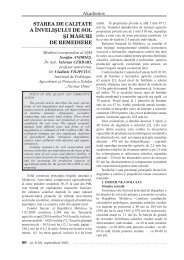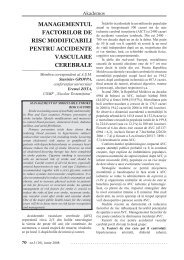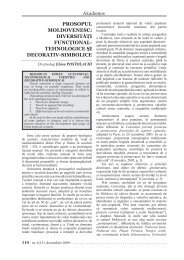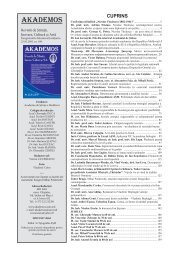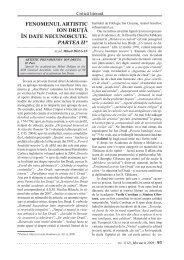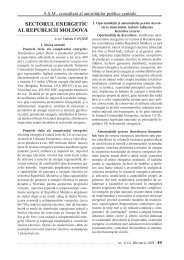Academos 3 2008.indd - Akademos - Academia de ÅtiinÅ£e a Moldovei
Academos 3 2008.indd - Akademos - Academia de ÅtiinÅ£e a Moldovei
Academos 3 2008.indd - Akademos - Academia de ÅtiinÅ£e a Moldovei
You also want an ePaper? Increase the reach of your titles
YUMPU automatically turns print PDFs into web optimized ePapers that Google loves.
Repere Bănci şi obiective<br />
CONFLICTS OF<br />
INTERESTS IN<br />
INVESTMENT BANKS<br />
....................................................................<br />
Ph.D. Andrei SIMONOV<br />
Michigan State University, Stockholm<br />
School of Economics and CEPR<br />
CONFLICTE DE INTERESE<br />
ÎN BĂNCILE DE INVESTIŢII<br />
Sunt studiate ultimele apariţii din literatura <strong>de</strong><br />
specialitate cu referire la confl ictele <strong>de</strong> interese<br />
în cadrul băncilor universale <strong>de</strong> investiţii, ce apar<br />
ca urmare a rolului proeminent al comerţului<br />
proprietar şi gestiunii activelor în banca universală.<br />
După cum se arată în literatura analizată, comerţul<br />
proprietar benefi ciază <strong>de</strong> informaţia oferită <strong>de</strong> către<br />
<strong>de</strong>partamentul <strong>de</strong> investiţii al băncii. Dat fi ind faptul<br />
că angajaţii băncilor <strong>de</strong> investiţii sunt membri ai<br />
organelor corporative <strong>de</strong> vârf, băncile <strong>de</strong> investiţii<br />
şi lucrătorii bancari a<strong>de</strong>sea oferă recomandări care<br />
contravin intereselor fi rmelor cliente.<br />
Investment banks are in the heart of mo<strong>de</strong>rn<br />
financial markets. From their humble origins in<br />
XIX century, investment banks were helping to<br />
provi<strong>de</strong> “soft” information to financial markets that<br />
cannot be codified in usual arm’s length contracts<br />
enforceable by the courts. In those distant times the<br />
investment banking was rarely involved in anything<br />
but advisory business. The most important asset<br />
that investment bank possess was reputation of its<br />
partners and employees. Capital that the investment<br />
bank possesses was almost unimportant. As In 1964<br />
Morgan Stanley chairman Perry E. Hall <strong>de</strong>clared<br />
that he didn’t see the need for more than $10 million<br />
in capital. Six years later, in 1970, Morgan Stanley<br />
had 200 employees worldwi<strong>de</strong> and $7.5 million in<br />
capital 1 . The reputation for honest business <strong>de</strong>aling<br />
was supported by semi-public service by leading<br />
investment bankers in form of corporate directorship.<br />
Sidney Weinberg who hea<strong>de</strong>d Goldman Sachs from<br />
1930-es till 1969 was sitting at 31 different boards<br />
simultaneously and was highly respected for his<br />
service 2 .<br />
In the last twenty years we observe well <strong>de</strong>fined<br />
movement towards more complex organization<br />
involved in other areas such as asset management<br />
and proprietary trading. Those changes were driven<br />
1<br />
Beard, Patricia, 2007, ”Blue Blood and Mutiny, HarperCollins<br />
2<br />
Sidney J. Weinberg, ”The Functions of a Corporate Director,” address<br />
before the Harvard Business School Club of Cleveland, May 31, 1949.<br />
Available at www.gs.com.<br />
by the <strong>de</strong>velopment in information technologies<br />
and financial theory. The most visible consequence<br />
of those theories is related to the <strong>de</strong>velopment of<br />
<strong>de</strong>rivative markets and related risk management<br />
techniques as well as creation of trading algorithms.<br />
As a result, traditional investment bank mo<strong>de</strong>l<br />
especially among “top tier” banks is becoming<br />
almost extinct. To put this statement in perspective,<br />
note that the abovementioned Morgan Stanley in<br />
2004 had 53,284 employees and $110.8 billion<br />
of capital 3 , an increase of 250 times in number of<br />
employees. At this point, significant fraction of<br />
revenues of large investment banks is coming from<br />
the sources other than advisory services. In Morgan<br />
Stanley the average over 2002-2004 was 13% of<br />
revenue, while Trading and Principal Investment<br />
brought 42% of revenues. For some (most notably,<br />
Goldman Sachs) advisory fees are almost pocket<br />
change in comparison with other sources.<br />
What are the consequences of that? As it was<br />
noted by Roger Altman (banker, also worked in<br />
Clinton Administration) noted that ‘at the big banks,<br />
investment banking is being downgra<strong>de</strong>d – the<br />
proprietary trading <strong>de</strong>sks are driving these firms<br />
now’ 4 .<br />
Regulators are perfectly aware about possible<br />
conflicts of interest and they erect “Chinese Walls”<br />
between different si<strong>de</strong>s of their business. We know,<br />
however, that those attempts often fail. The role<br />
of Deutsche Bank Investment Banking division<br />
in changing the vote of DB Asset Management in<br />
Compaq-HP merger is well known. In the SEC’s<br />
June 2006 SEC issued administrative or<strong>de</strong>r against<br />
Morgan Stanley, for allegedly failing to maintain and<br />
enforce written policies and procedures to prevent the<br />
misuse of material nonpublic information. According<br />
to the Or<strong>de</strong>r, which was entered without admitting or<br />
<strong>de</strong>nying liability, Morgan Stanley “violated Section<br />
15(f) of the Exchange Act and Section 204A of the<br />
Advisers Act” by failing to (among other things)<br />
surveil activity in certain securities tra<strong>de</strong>d in Morgan<br />
Stanley’s proprietary accounts; and provi<strong>de</strong> a<strong>de</strong>quate<br />
written guidance in the firm’s policies and procedures<br />
about such trading”.<br />
Recent paper I wrote with Massimo Massa and<br />
Andriy Bodnaruk 5 is <strong>de</strong>aling with trading done<br />
by different asset management and proprietary<br />
trading divisions of investment banks in the <strong>de</strong>als<br />
that banks advise. We looked at the US Mergers and<br />
Acquisitions market for the period January 1984 -<br />
February 2003. We analyze the relation between the<br />
fact that the advisor to the bid<strong>de</strong>r holds a stake in the<br />
3<br />
Morgan Stanley Annual Report, 2004. Available at www.sec.gov.<br />
4<br />
’When a boutique bank is big business’, James Politi, Financial Times,<br />
February 5. 2006.<br />
5<br />
Bodnaruk, Andriy, Massa, Massimo and Simonov, Andrei, “The<br />
Dark Role of Investment Banks in the Market for Corporate Control”<br />
(December 2007). EFA 2007 Ljubljana Meetings Paper Available at<br />
SSRN: http://ssrn.com/abstract=966202.<br />
nr.3 (10), iunie 2008 - 29



